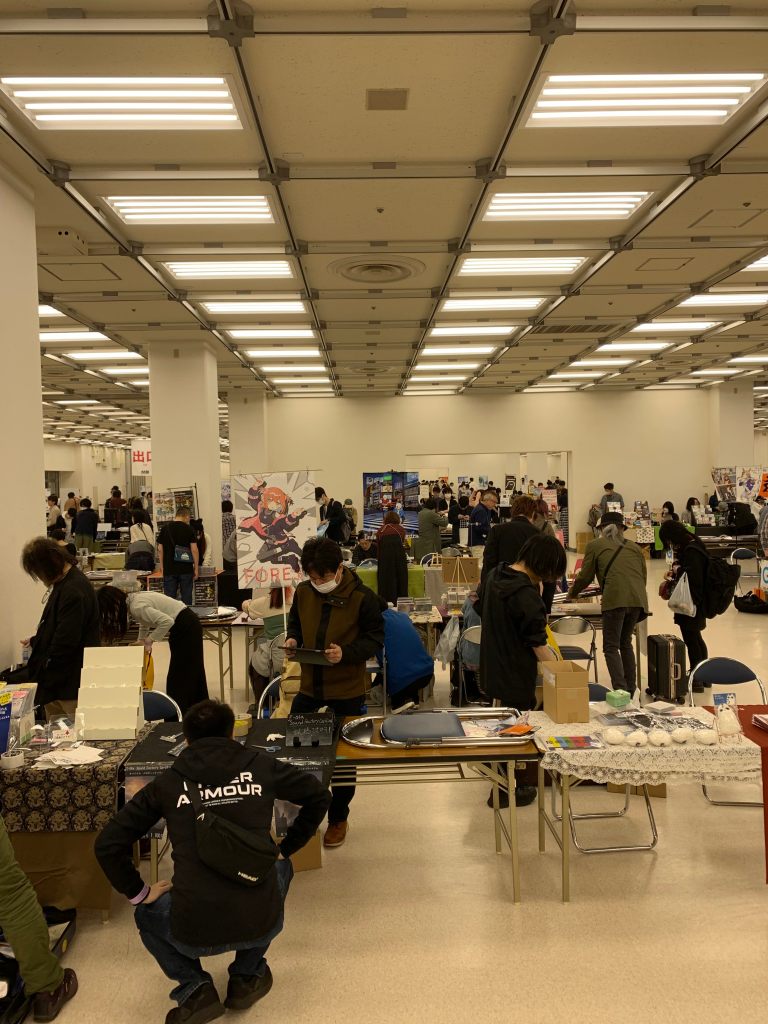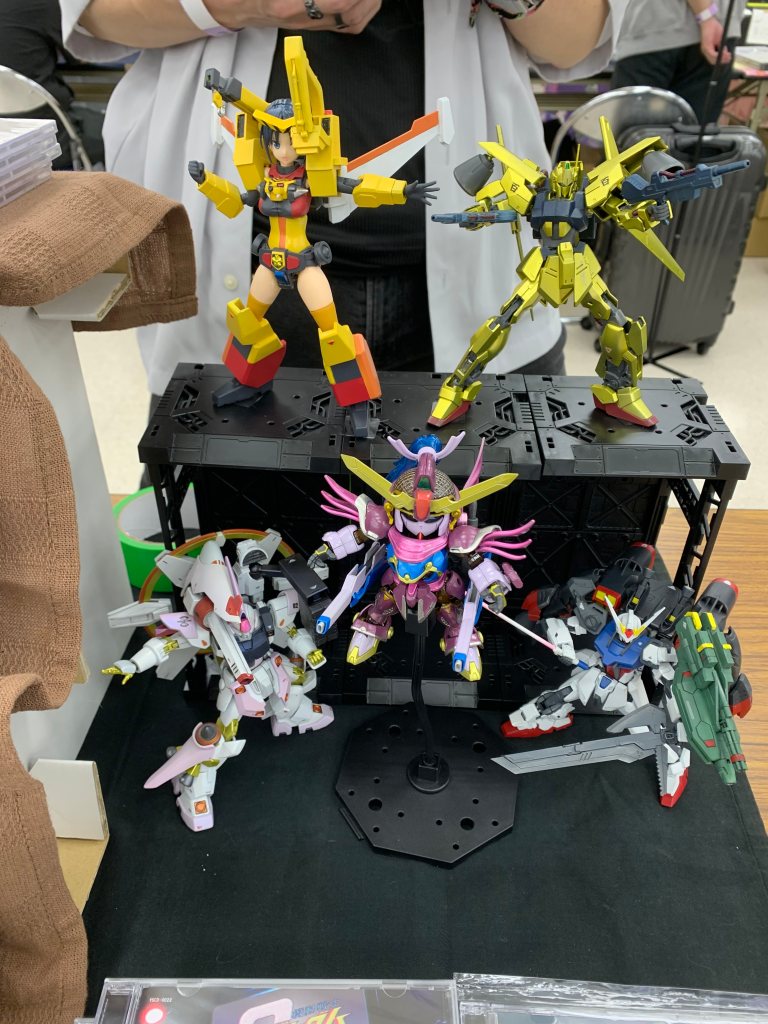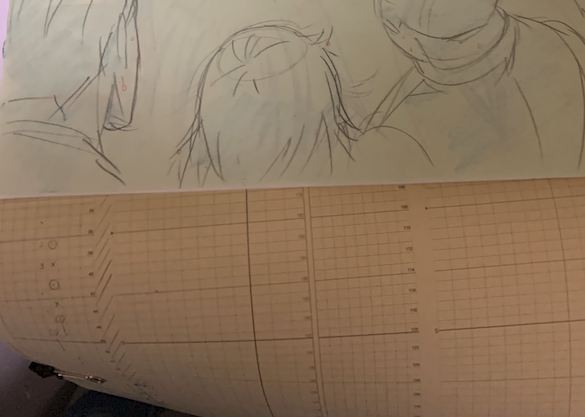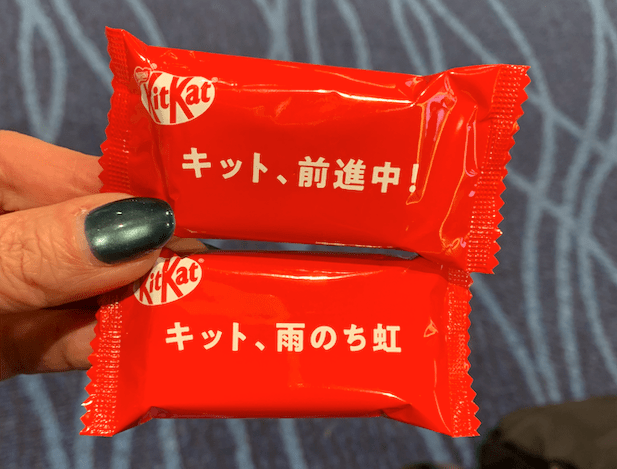Desk? Still messy. Brain? Same.
シンディは夜ふかし中。多分今日も、机の上は散らかってる。
-

ブログ
【さよなら丸の内TOEI ×超クウガ展】トークイベントレポート
2025/05/295月24日、銀座・丸の内TOEIで開催された『さよなら丸の内TOEI ×超クウガ展』上映会&スタッフトークイベントに参加してきました
この劇場、今年7月27日で取り壊されるとのことで、65年の長い歴史に幕を下ろすそうです。そんな貴重な時期に、TV作品である『仮面ライダークウガ』の上映とトークが行われたこと自体が、ファンにとっては奇跡のようなイベントだったと思います。
*以下は当日の私の記憶をもとにしたレポートです。メモを取っていたわけではないので、順序や細部に誤りがあるかもしれませんが、イベントの雰囲気を感じていただけたらうれしいです。
登壇者トーク:高寺Pが軽快に飛ばす!
登壇されたのはMCの鈴村展弘監督、高寺成紀プロデューサー、脚本家の荒川稔久先生。冒頭から高寺Pのトークが絶好調で、Xで見せる硬派な印象とはまた違い、とてもフレンドリーで愉快な方でした。トーク慣れもされていて、個人で配信チャンネルを持ってほしいくらい。(ひょっとしてあるのかしら?)鈴村監督から「この劇場に映画を観に来ることはありますか?」という質問がお二人に対してありました。かつてこのビルの上階に喫茶店があり、荒川先生はそこでよく打ち合わせをしていたとか。皆さんお仕事以外でこの劇場を訪れる機会は少なかったようです。
上映:エピソード17「臨戦」
最初に上映されたのは、総集編エピソードである第17話「臨戦」。とはいえ、ちゃんと新規の未確認生命体第25号・メ・ガドラ・ダが登場するなど、監督のこだわりが詰まっている回です。グロンギの設定上、本来なら傷が回復するはずなのに傷跡が残っていたり、怪人能力ではなくチェーンとメリケンを武器にしているところが地味に無骨で男らしいですよね。実際、やたら強いですし。
鈴村監督にとって、この第17話が監督デビュー作となりました。
総集編が制作されることになった背景には、当初予定されていたエピソード――五代雄介の小学校時代の教師・神田先生の話(もともとは五代の叔父さんが中心のエピソードだったそうです)――の脚本が遅れたことがあったそうです。当時、鈴村氏は助監督。長石多可男監督への配慮もありつつ、シナリオの遅れについてはかなりはっきりと指摘されたとのこと。一方で、長石監督は「いい脚本ができるなら、待ってもいい」というスタンスだったそうです。
脚本はラフ稿の段階までは進んでいたものの、映像チームとの打ち合わせ時には決定稿が間に合っておらず、それでも大きな修正はないだろうと鈴村助監督は判断し、ロケハンなどを進行。しかし、実際に上がってきた脚本はまったく別の内容になっており、大幅なスケジュール遅延は避けられない状況になってしまったそうです。
そうした経緯から総集編を作ることになり、鈴村助監督は「初期から関わってきた自分がやるべき」という思いを持っていたそうで、かなり強く希望されたというエピソードが印象的でした。
高寺Pによれば、当初はローテーションの監督陣の中から誰かを選ぶ可能性もあったそうですが、鈴村助監督の熱意が決め手となって任せることになった――という記憶があると語られていました。
鈴村監督と師匠・石田秀範監督の豪快伝説
鈴村監督の師匠は石田秀範監督。第1話の九郎ヶ岳遺跡のロケハン時、鈴村助監督が運転してる最中に石田監督が「あそこがいいから見てこい」と言われて崖下まで確認に行かされたというエピソードが披露されました。しかもその場所へは川を越える必要があり、トラックで資材搬入のために橋を架けたという驚きのエピソードまで披露。しかし、本編映像で使われたのはたったの2カット…もう豪快としか(笑)『クウガ』の前にお二人が参加された『燃えろ!!ロボコン』の現場でも、石田監督が希望されたロボコンが乗れるサイズのブランコの製作費があまりに高かったので、一回だけではなくまた使ってほしいと制作(?)に言われたらしいです。
『クウガ』の空撮素材も、1話のヘリでの撮影時に撮り溜めておいたものがあったらしいのですが、後にメ・バヂス・バが登場する7・8話ではロケ地の整合性の関係で「場所が違うだろう」と石田監督に却下され、結局またヘリを使って撮り直しになったそうです。予算や手間を考えると、そのこだわりを貫くのは大変だっただろうと思いますが、そこがまた「クウガ」らしいな、とも。
あと、どの話数だったか失念してしまったのですが、荒川先生が脚本に「潰れた車」と書いたものを再現するのに、石田監督に言われて鈴村助監督は駐車場でひとりで車に鉄骨を落とし、火をつけて車を破壊するという現場作業もしていたとか。さすがに周囲に鈴村が変になったんじゃないかと思われたのでは、とおっしゃってました(笑)
ちなみにこのあたりで、「SNSに“鈴村が石田監督の悪口言ってた”って書かないでね!?」と注意喚起が…と思ったら、客席に石田監督ご本人がいらしてたのを高寺Pがあとになってから発見したというオチまでついていて、観客としてはなかなか面白い展開でした(笑)仕込んだんじゃないとしたら、相当気まずい状況ですけど、帰りは仲良く一緒に撮った写真がXに載っていたので安心しました!
荒川稔久先生の“巻物FAX”とリアリティへのこだわり
荒川先生は、ドラマ内の移動距離や時間軸に整合性を持たせるため、地図を広げながら執筆していたそうです。高寺Pの赤入れが厳しくて、FAX対応のため黒ペンで細かく修正を送っていたという話も印象的。当時まだ小さかった先生の娘さんが延々とFAXから吐き出される感熱紙を怖がっていたという微笑ましいエピソードも。感熱紙ってロールですから…そこにびっしり文字が書いてあったら視覚的にインパクトありますよね。
特典映像「検証~ドキュメント・オブ・クウガ」上映
後半は、Blu-ray特典映像「検証 ~ドキュメント・オブ・クウガ」を劇場の大スクリーンで鑑賞。自宅で観たときとは印象がまったく違い、没入感たっぷりでした。トークとあわせて観ることで、作品世界の裏側により深く入り込めた気がします。
『検証』を手がけた古波津陽監督と近藤あゆみプロデューサーも登壇されました。
お二人は、あえて仮面ライダーという文化に馴染みのない立場から選ばれたそうで、『クウガ』を初めて通して観たことで、「怪人が出てきて戦うだけの作品」ではなく、「これはドラマなんだ」と印象が大きく変わったと語られていました。そうした視点をもとに、スタッフへのインタビューで何を聞くべきかを精査していったとのことです。「これまでのヒーロー作品を変えたい」という強い思い――「パンクの精神」とも表現されていますが――そうした熱意がひしひしと伝わってくる、素晴らしいドキュメンタリーでした。
映像の最後には、高寺Pの「人間は何もしなくても死ぬ、戦うことは無意味」という印象的なコメントで締めくくられます。このあたりのテーマ性も含め、ぜひご自身の目で『検証』をご覧いただきたいです!
「超クウガ展」の話題とサプライズ発表
イベントの最後には、「超クウガ展」プロデューサーの中舘充樹さんが登壇。「クウガ」直撃世代とのことで、25周年を機に今回の企画を2年前から高寺Pに相談されてたそうです。
美術デザインを担当された木村光之氏が保管していた多数の図面も、今回の展示で公開されるとのことでした。登壇されていたスタッフの皆さんも「こんなに残っていたとは」と一様に驚かれていました。
また、高寺Pご自身も『クウガ』のシナリオを、初稿からすべてご自宅で保管されているとのことで、その徹底ぶりに荒川先生も感激されていました。
高寺Pは、ウルトラマンのデザインを手がけた成田亨氏が全てのデザイン画を保管していたことに触れつつ、木村氏も『クウガ』という作品を特別なものとして、大切に図面を残されていたのではないかと語っておられました。
美術のこだわりが感じられる話として、36話で未確認生命体第43号・ゴ・ザザル・バを追い詰める場面のロケ地は、実はただの駐車場だったそうです。
それを大江戸線の地下倉庫施設のように見せるため、多くの大道具小道具を持ち込んで撮影が行われたとのこと。言われてみれば、確かにあの空間、普通の駐車場には見えません…。そしてサプライズ発表!あの“バラのタトゥの女”ことラ・バルバ・デの怪人体の立体化が展示されるとのこと!放送当時、デザインだけはされていたそうなのですが、七森美江さんが最後までご出演されてたので、怪人体を出すタイミングが結果的になかったとのことです。彼女は手だけたまに変異する以外はずっと人間体でしたから、25年経った今、それが見れるのには感無量です。小説版でも完全変異した姿の描写はありませんでしたものね。まあ、彼女には美しい女性の姿のままでいてほしいという気持ちがないでもないですが。
当日夜21時までは告知NGとのことで、帰宅してからXをワクワクしながら待機しておりました。
おまけ:36話のあのエレベーター
ロビー奥のエレベーター、実は36話でゴ・ザザル・バがゲゲルに使った「動く箱」の一つだったそうです。最後に写真を撮ろうかと思ったのですが、人が多すぎて断念…。取り壊し前に訪れる機会がある方は、ぜひ記念撮影を!
丸の内TOEIの閉館前に、こんなにも濃密なイベントが行われたこと、本当に貴重な体験でした。クウガを愛し、作り、語ってきた方々の熱量にふれることができて、心から感謝です。

【なかなかアクティブな1日】
2025/05/14昨日は私にしてはめずらしく予定を詰め込んだ一日でした。
リモート打ち合わせ → 作業 → ネイル → 荻窪で会食 → 帰宅後に再び作業、という流れで、大したことないように見えて、普段引きこもり体質の私にしてはかなりアクティブ。家にこもって作業する分には平気なんですけど、近所であっても外出が絡むと途端にソワソワするタイプです(笑)
キャラクター色味チェック
午後はリモート打ち合わせからスタート。内容はキャラクターの色味チェックで、色彩設計の方が作ってくださった配色案を、監督と一緒に確認しました。
この時点で残っているのはほぼサブキャラのみ。私が担当した2体はさくっと終わり、あとは他の方にお任せして会議を退室。そのまま次の予定まで少し時間が空いたので、軽く作業タイム。
ネイルサロンでの雑談
夕方は駅近のネイルサロンへ。
担当のネイリストさんがほどよくオタクなので、いつも話が尽きません。今回は「大阪万博のコスプレどう思います?」というタイムリーな話題から始まり、ChatGPTの話に。そしてなぜか「AIに手相占ってもらうとおもしろいですよ!」という流れに(笑)
私はこれまで一度も手相を見てもらったことがなく、「しわで人生ってわかるんかい…?」と思いつつ、きっかけがあればなんでも試してみたい性分です。手のひらの写真をアップロードするだけで、性格や人生の傾向まで分析してくれるのですが…当たってる当たってないはさておき、手相占いとはこういうことなのかという内容。しかし、今このネタを引っ張ってもしょうがないので、また別のブログとして書くのもありかも?今回のネイルはキラキラ多め
さて、今回のネイルは前回の淡いラベンダー系とは打って変わって、キラキラ多め。マグネットネイルにストーン、ホログラムパーツなど派手にならない程度に盛ってもらいました。やっぱり濃いめの色が入るとテンションが上がりますね。

怪獣とハンバーガー
ネイルのあと、ささっと手土産を買ってから荻窪のヴィレッジヴァンガード・ダイナーへ。
自宅から近いのに本当に久しぶりの来店。
この日の目的は、怪獣フィギュアを譲ってくださる知人との会食でした。
お迎えしたのは、ピット星人・キーラ・サイゴという激渋ラインナップ。
キーラとサイゴは、フィギュアを見るのは初めてなのでテンション上がりまくりです。持ち物の断捨離をされているとのことで、今回ウルトラ関連を引き取らせていただきました。私にしても、物を増やしてる場合じゃないんですが……まあ、それはあとで考えますよ(笑)
さすがにダイナーのど真ん中で開封するのは気が引けたので、中身をちゃんと見たのは帰宅してから。いや〜、いいですね…..。飾る場所を作るのもまた楽しい時間です。

ここのダイナーは基本的にバーガー一択のメニュー。私はペッパーチェダーメルトバーガー+ポテトを注文。ケチャップ&マスタードをこれでもかとジャブジャブかけて、アメリカンスタイルでがっつきました(笑)
相手の方は和牛バーガーをきれいに完食。バーガー、久々に食べると本当においしいですね(いうても、3月のハワイ旅行以来なのでそれほど久々でもないかも…。)
最後にもうひと仕事
帰宅後は30分ほど仮眠してから、再び作業タイム。
外出そのものよりも、支度にエネルギーを使うタイプですが、帰ってきた頃には気持ちもお腹も満たされていて、集中力も高めでした。少しだけ外に出て、人と話して、ネイルして、怪獣を愛でて。
これでまたしばらくがんばれます!
【M3 2025参加レポート|シン大和工房のお手伝いに行ってきました!】
2025/05/01先日、音系・メディアミックス同人即売会「M3(えむすりい)」に参加してきました。
……といっても、自分の創作物を引っ提げての参加ではなく、知人のサークルのお手伝いとして急遽ブースに立つことになりまして。
声をかけてくれたのは、サウンドエンジニア、そしてボーカリストでもある大和稟さん。サークル名は、私たちがコミケ用に立ち上げた「シン大和工房」。彼にとってはなんと7〜8年ぶりのM3参加だったそうです。
予想以上の賑わい
会場は東京流通センター(TRC)。羽田空港の一歩手前くらいという印象で、個人的にはかなり遠かった…!
とはいえ、ビッグサイトと違って駅から会場までは徒歩すぐ。待ち合わせもスムーズで、あの「延々歩かされる苦行」感がなかったのは助かりました。
そして、中に入ってびっくり。想像していたよりもずっと大規模で、サークル数も多く、かなり賑わっていました。全く知らずに参加したのでその場でさくっと調べてみたところ、M3は年2回開催され、来場者はなんと1万人規模とのこと。

今でもCDで勝負している世界がここに
M3は「音系・メディアミックス同人即売会」と銘打たれていて、音楽ジャンルに特化した即売会。いまや配信が主流の時代に、プロもアマも入り混じってCDで作品を頒布し続けている空間が、こんなに大規模に存在しているとは思いませんでした。
もちろんCDだけではなく、缶バッジやTシャツなどのグッズもあり。コスプレ姿の売り子さんもちらほら見かけました。
音楽ジャンルだからもっとアーティスト然とした人たちばかりかと思いきや(←偏見)、会場の雰囲気はコミケとそれほど変わらない印象でした。

シン大和工房のCD、完売
大和さんの頒布作品は、80年代アニメ、ガンダム、特撮などをモチーフにしたカバー曲CD集。ジャンルごとに何種類か制作していて、どれも力作です。
特に人気だった2種類は、なんと完売!さらに、大和さんが制作したガンプラも展示していて、それに興味を持った方々が立ち止まってくれる姿も多く見られました。新しいガンプラ友達ができたようで、見ていてちょっとほっこり(笑)

ネットがつながらない!
唯一困ったのは、会場内のネット環境。とにかくつながりにくくて、もし当日スマホ頼みだったらと思うとちょっと冷や汗でちゃいます。
やっぱり<紙のリストと事前準備、大事!>と再認識した瞬間でした。
気になる列と、気になる漫画
昼頃から、ブース前の通路にやたらと長い列ができ始めて、しかもどんどん伸びてしまいには2列構成。どうやら握手会が行われていたようなのですが、誰のものだったのかは最後まで謎のまま…。
列ができると人の流れが悪くなってしまうので、帰りの混雑も考慮して、私たちは13:30頃から撤収準備を始めました。
ちなみに私自身はリサーチ不足で他のサークルをほぼチェックできなかったのですが、たまたま見かけた同人誌オンリーのブースでクラシック作曲家をモチーフにした漫画を2冊購入。ページ数は32~36ページくらいなので確かに「薄い本」ではあるんですが、本の編集も漫画もプロだとわかる内容です。作曲家とその楽曲誕生のエピソードが漫画で描かれており、解説も付いて読み応えあり!

そして打ち上げは炭水化物祭
撤収後は、シン大和工房恒例(?)の打ち上げへ。
新宿でパスタ食べまくりの炭水化物祭です。こういう打ち上げがあると、(何もしてない割には)達成感がありますよね。
とび入り手伝いでしたが、ジャンルを超えて音楽を作る人たちが集う空間に触れられて、とてもいい刺激になりました。また機会があれば、今度はちゃんと自分でも事前チェックしてまわりたいと思います!
【私のコミュニケーション事情:2025年版】
2025/04/26
クライアントのやり方に合わせる
昔、フリーランスを始めた頃は、連絡手段といえば電話くらいしかありませんでした。それが今では、クライアントごとに使うツールも違うのが普通です。
ビデオカンファレンスを好む会社もあれば、SNSのメッセージ機能、メール、そしてだいぶ減ったけど電話…と、様々です。
ワンオペの私は、NotionやSlackといったプロジェクト管理ツールは使っていません。制作会社では使ってるところも多いんでしょうね。なんとなくかっこよくて、ちょっと憧れます(笑)
Zoom時代のはじまり、そしてTeamsとの格闘
個人用には長いこと(今は亡き)Skypeを使っていましたが、仕事で最初に使ったビデオカンファレンスツールはZoomでした。リモート会議が一気に普及したコロナ禍、まだ壁紙機能もなかった頃です。
うっかりすると部屋の中が丸見えになるので、背景にはけっこう気を遣っていました(笑)
その後、情報漏洩の問題もあって仕事利用のZoom離れが進み、一瞬 Google Meetも使われてましたが、今では私の周囲ではMicrosoft Teamsが主流になっています。
ただ、Teamsの会議に初めて参加したときは大変でした。
グループに入ろうとしてももたつくし、接続が途中で切れるしで、正直「なんだこの扱いにくさは」と思ったものです。そして何度か失敗して、ようやく気づきました。
──あ、ブラウザのせいかも。Macユーザーの私は、うっかりSafariでアクセスしていたんですが、どうやらTeamsはChromeの方が安定してる様子。
まぁ、Microsoftのサービスですしね。うん、そりゃそうだ(笑)
ちなみに、内蔵マイクがデスクトップファンの音を拾いまくるので、わざわざPCマイクも買いました。が、OSアップデートで非対応になり、あっという間に使い物にならなくなりました。…..次はちゃんと調べてから買おうね、私。
こんなふうに新しいツールに戸惑うこともありますが、
強制的に覚えるチャンスだと思って、なるべく前向きにとらえています。LINEはどうしたものかと
2025年にもなって、私はいまだにLINEを使っていません。
仕事でもプライベートでも、ゼロです。もともと自宅作業が中心なのでPCメインだし、スマホは必要最低限しか見ない派。
セキュリティの不安も表向きの理由のひとつですが、電話番号と紐づくLINEは、一度教えてしまうと「いつでもメッセージOK」な空気になりがち。そのくせ、長文のやり取りには向かない仕様なので、仕事の話を詰めるにはなんとなく不便そうに見えます。
LINEをやってないと伝えると、
「えっ、今どきそんな人いる!?」
と、珍しい生き物を見るような目で見られます(笑)一部の制作会社では、過去の情報漏洩を受けて仕事のLINE利用禁止にしているところもあります。社員の退職後であっても業務内容が個人の端末に残ってしまうわけですから、確かに色々なリスクがありますよね。
そんなこともあり、制作とのやりとりでLINEが必須ということもなく、自分もそこまで重要性を見出せていないというところでしょうか。プライベートと仕事の線引きが難しいツールでもあるので、意識的に距離を取っています。
(しのごの書いてますが、結局のところ面倒臭いだけです…..)
イーロンが嫌いでも、XのDMは手放せない
現時点で、X(旧Twitter)のDM機能は一番手軽な連絡窓口になっています。ある程度スパムも防げるし、気軽にメッセージできるのはやっぱり便利。
イーロン・マスクの動きには正直モヤモヤしっぱなしですが、
そんな個人的な思いは横に置いといて、今のところは「実用優先」で使ってます。最近は絵描きさんたちがBlueSkyに移動してしまい、Xで絵を見かける機会はかなり減りましたね。
私はもともと落書き投稿も控えめだったので、Xの利用規約による大きな影響はなかったけれど、一応過去の画像投稿はほぼ削除しました。
それでも、
「先日Xでイラスト拝見しました!」
というDMとともに美少女系の仕事依頼が届くと──ありがとう、でもまあ、嘘だよね?
と、心の中でツッコミを入れながら返信してます(笑)利用規約と仕様変更にはいちいち振り回されますが、DM機能の便利さとポストの拡散力を考えると、今はまだ手放せません。
メールはバリバリ現役
このサイトに、仕事用の公開メールアドレスを載せています。
あらかじめ自分の状況や希望条件を明記しておくことで、
以前は多かった条件違いのオファーや無理な電話営業がほぼなくなりました。先方のお時間も無駄にせず、自分のストレスも減り、ちゃんとお知らせするというのは大事だなと思いました。
それに、正式なやり取りや長文のやりとりには、やっぱりメールが一番安心なんです。電話だと「言った・言わない」問題がどうしても発生しやすいですからね。
ちなみに、メールの整理術はたいしたことはしてなくて、大体こんな感じです。
- フィルターを活用する(特にyahooドメイン、君たちは全員ゴミ箱直行だ)
- まとめて対応する時間を決める
- 送信者別にフォルダー分け(重要度で分けるのはうまく行かなかった)
- 活発なやり取りがあるクライアントが同時に複数いる場合、誤爆防止に別のアドレスに振り分けて使うことも
- いくつかあるメールアドレスから1箇所へ自動転送して、まとめて見れるよう設定
完璧な運用はできてないですが、自分の事務処理能力がパンクしないくらいの整理術は維持しなければ、と頑張っています。
速さは大事。でも、疲れないほうがもっと大事
即レスは、求める方も、求められる方も、疲れます。
速さと利便性を追い求めて、新しいツールに次々手を出し続けるのも、やっぱり疲れます。どんなに便利なツールができたとしても、結局それを使う人間のスピード以上にはならないんですよね。
私につながる方法は、今のところいくつか既に用意されています。
それ以上を求められている実感もないので、現状はこれで十分かな?でも、もしクライアント側がさらに新しいツールを導入するなら、そこには柔軟に対応していこうと思っています。フリーランスは、変化に前向きじゃないと続かない世界ですから。
……というわけで、2025年こそ、重い腰を上げてLINEを始める日が来るかもしれない──
いや、やっぱり来ないかもしれない(笑)
【タロットカードの世界にちょっとだけ足を踏み入れてみた】
2025/04/17私は占いを特に信じているタイプではありませんし、星座占いもエンタメの域を超えない感じです。ただ、タロットカードには少し前から妙に惹かれるところがありました。
女子だと何かしらタロットカードに縁があったりするものなんですが、私のきっかけは少女漫画(あしべゆうほ先生の『デイモスの花嫁』だったかな…)にタロットが登場したり、雑誌の付録でタロットカードがついてきたりして。そして同級生の一人が急にタロット占いにはまり出したこともあり、よくわかっていないながらもなんとなく身近な存在でした。
そのうち、自分でもタロットデッキを買いました。ウェイト版という、一番スタンダードな絵柄のやつです。占いを覚えたかったというよりも、カードの絵がとにかく謎めいていて魅力的だったんですよね。
大アルカナは「世界」とか「死神」とか、テーマが大きくて壮大な感じ。でも小アルカナのほうは、何かが起きている最中の登場人物が描かれていて、まるで絵本のような物語性があって好きでした。スプレッド(展開方法)とかは全然覚えず、ただ絵柄と解説書を眺めて満足していた記憶があります。典型的な「形から入る」タイプですね、はい(笑)
多分、大昔の人たちもこれと同じようなデッキで、真剣に自分の未来を占ってもらってたんだなって思うと、それだけでちょっとしたワクワクを感じてたんだと思います。
でもその後は、特に占いに嵌まることもなく、いつの間にか忘れてしまっていました。
YouTubeの占い動画を見始めたきっかけ
仕事以外であまり絵を描かなくなっていた矢先に、ふとタロットカードのことを思い出しました。「あれって描く題材としては大変だけど、ちょっと面白そうかも?」と。
合計78枚あるので正直ボリュームはすごいんですが(笑)、全部描こうと気負わず、まずは気になるカードからゆるく描いてみようかなと思い立ちました。でもカードの意味や使い方はすっかり忘れていたので、まずは情報収集をかねて、YouTubeのタロット占い動画を見始めたのが去年の秋ごろです。
星座別に「今週の○○座」といった感じの動画を中心に、日本と海外の両方を観察していました。占い師さんたちは各々のスタイルを持っているようですが、複数のタロットデッキを使う方が多く、さらにオラクルカード(短いメッセージが書かれたカード)やラッキーカラー、動物カードなどを組み合わせて、ひとつのテーマをより詳しく掘り下げていくスタイルが主流のようです。
中にはやりすぎてテーブルがカードだらけになっていて、見ているこちらが混乱することも(笑)
カードの引き方にもいろいろあって、「7枚引き」(上から7枚目のカードを使う)や「ジャンピング・カード」(シャッフル中に飛び出してきたカードを使う)という方式もあります。特に海外の占い師さんはシャッフルの動きがダイナミックで、カードが勢いよく飛び出しまくる場面も多々。ジャンピング・カード向きだなと思います。
カードのデザインも多様で、ぎっしり描き込まれたものから抽象的なもの、ゆるキャラ系までさまざま。中にはぱっと見で何のカードかわからないものもあるので、自分で描く場合はやっぱり基本に忠実な、分かりやすいスタイルが親切かなと感じました。画風が凝りすぎていると、占い師さんたちもカードの絵にある要素を深読みしすぎて一枚に費やす時間が長くなりがちだったりしますし。
同じカードが出まくる件
見始めた頃に気がついたのが、「隠者(The Hermit)」のカードがやたらといろんなリーディング動画に出てくることでした。しかも、1つの動画の中で複数のデッキを使ってリーディングしているときに、違うデッキから「隠者」がまた出てきたりするんですよ。たしか9月頃だったと思います。
隠者って、絵柄的にはランタンを持った山の上に住むおじいちゃんなんですが、タロットでは乙女座を表す内省のカード。私はまさに乙女座で、自分の星座に対応するカードが出ると、より強い意味を持つとされているらしく、余計に印象に残ったのかもしれません。

そうやって違う占い師さんたちの動画でも同じ絵柄のカードが出てくることがあり、カードは違っても最終的に似たような結果が出ることもあります。「最近、引っ越しの流れが来てますよ」「今関わってるプロジェクトが公表されたらSNSでバズりますよ」など、わりと具体的なことを言っているにもかかわらず、複数の動画で似た内容が出てくると、さすがに不思議に思いますよね。とはいえ、世界中の乙女座の人たちが同じ時期に引っ越したりバズったりするわけではないので、未来予測としてはさておき、って話にはなりますが。
偶然と確率
で、思い出したのが、量子力学の「観測によって性質が決まる」という例の話。タロットカードも、意識とリンクしてリーディングに影響を与えてるなんてことあるかもな〜…などと不可解な“仕組み”があると考えた方がスピリチュアル的には正しい方向性ですよね。いや〜、この偶然と確率のはざまに揺れ動く感じが実に興味深いです。
観察が楽しい
信じる信じないは人それぞれでいいと思うし、私はどちらかというと「面白い現象として観察している」くらいのスタンスです。
最近はさすがに見る頻度は減ってきました。というのも、だんだん「興味を失う動画の傾向」がわかってきたんですよね。これはほんとに個人的な好みの話なんですが、カードを捲るときに掛け声などのちょっと演出っぽいノリが入ると、そっと閉じたくなってしまいます(笑)きっとそういうスタイルを教える流派があるんでしょうけど、私は静かにめくってくれたほうが好みです。
スピリチュアルに話が向かうと、だんだん何を言われてるのかわからなくなってくる瞬間もあります。「魂」「運命」「宇宙からのギフト」といった壮大な言葉が連発されると、ちょっと理解が迷子になるというか…。
そんなこともあり、1枚のカードを長々と語るスタイルも、時には少し重たく感じてしまいます。リーディングというより説法のようになってしまうというか。でも、どんなカードにも意味を込めて、ポジティブな方向に解釈していこうとする姿勢はとても誠実だと思いますし、そういう発信が救いになる人もたくさんいるはずです。
私自身はあくまで「絵を描く上でカードがどう解釈されるか」が知りたくて見ているので、どうしても好みによって視聴を選ぶ感じにはなっちゃいますが。
ここまで書いたら描かないとね
なんだかんだ、タロットカードって想像力を掻き立てられる題材ですよね。今は、自分でも無理なく描き続けられる絵柄を模索中です。…って、去年の秋から考えてるわけですから、そろそろ描けよって話なんですが(笑) まあ、気長にお待ちくださいませ~!
【とあるアニメーターの在宅ワークの1日】
2025/04/13
最近ではすっかりリモートワークが当たり前になりましたよね。私も典型的なフリーランスのアニメーターなので、基本は自宅で作業しています。
今回はそんな私のリアルな1日をご紹介してみようと思います。
……と書き始めたはいいけど、おもしろいのか、これ?(笑)
朝は10:30スタート。まずは口をゆすぐところから
アラームは一応セットして、なるべく10:30までには起きるようにしています。
(とはいえ、すぐにベッドから出られるかはその日次第…)なぜ10:30なのかと言いますと、近所の保育園から、ちびっこの元気な声が聞こえ始めるのがちょうどこの時間。昼まで寝ていたくても、必ず一度は起こされてしまうので、もう起きることにしています。
起きてから最初にするのは、洗顔と「しっかり口をゆすぐ」こと。
“寝ている間に口の中の雑菌が爆発的に増える”という話を聞いてから、朝の水を飲む前には必ず口を清潔にするようになりました。これをサボると、なんとなく体調を崩しやすい気がして、今では完全に習慣になっています。まあ、おまじないですけど。
着替えながらPC起動。そしてしっかり朝ごはん
コーヒー用にお湯を沸かしながら、パソコンを立ち上げます。
そのあいだに作業用の服に着替えて、頭と体を仕事モードに切り替え。部屋着のままだと気が抜けてしまうので、本当は外出できるくらいの服装が理想なんですが……実際のところ、ほとんどの日は“戦闘服”と化したジャージで済ませています(笑)
朝食はほぼ定番化されたルーティンメニュー:
- ライ麦入りイングリッシュマフィンをトースト
- アボカド、チーズ、ベーコン、レタスを挟んでサンドイッチ
- 白湯を一杯、コーヒーはクリームのみ
食後は歯を磨いて味覚をリセット。軽くストレッチをしてから、メールとSNSチェックへ。

やる気ゼロでも、ルーティンでエンジン始動
ここまで見ると、なんだか朝から充実している人っぽいですが、実際にはこの時点でのやる気はほぼゼロです(笑)
だからこそ、ルーティンの力を借ります。
「今日やらなきゃいけないこと」をホワイトボードで確認したり、脳内でリストアップしたりして、軽く“危機感”を煽る。「これ放置したらマズいかも…」と思ったところで、ようやく本格的に始動します。まだ頭がしゃっきりしない朝の時間帯は、前日の作業の続きをそのまま引き継ぐのが一番スムーズ。作業スペースが狭いこともあって、デジタル用とアナログ用で机の上を入れ替える必要があるんですが――この“ひと手間”が、地味に勢いをくじいてしまうんです。
メール返信や書類チェックといった「気が重い系」のタスクは、ある程度脳が温まってから。そうしないと、ぼーっと長い時間文面を眺めて終わってしまうんですよね。
昼ごはんは13:00前後。基本はパスタ!
お腹が空いていなくても、なるべく13時前後には昼食タイム。
一時期は近所のお弁当屋さんに頼っていたのですが、続けていたら……あっという間に太りました…
というわけで、今はできる限り自炊するようにしています。最近のお気に入りは、レモンとチキンとブロッコリーのパスタ。
ヘルシーで作るのも簡単。とはいえ、多少は手間がかかるので、忙しい日は市販のソースに手を加えて済ますことも。「今日なに食べよう」と考えるのが面倒で、結局いつも同じメニューに落ち着きがち。食に対する執念があまりないぶん、それでも意外と長いこと飽きずに続けられます。
とはいえ、毎日カロリーメイトみたいな“宇宙食系”で済ませられるほどストイックでもありません(笑)
眠気予防のために、食事は小分けにして一気に食べすぎないのが自分ルール。
パスタって、つい多く茹ですぎちゃうんですよね…普段は、録画した番組やニュースを観ながら食事することが多いです。
「ながら食べ」は身体に良くないとも言われますが、黙々と食べるだけって、意外と難しくありませんか?午後の仕事は、優先順位で時間割り
私は常に2〜3本の案件を抱えていて、納期や契約条件に応じて優先順位を決めています。
- メイン案件には、毎日しっかり作業時間を確保
- その他は、空いた時間に割り振って対応
制作から伝えられる締切日から逆算して、どれくらいのペースで何をやるかはざっくりと自分で決めています。
打ち合わせのほとんどは、午後の時間帯にリモートで行われます。
色の確認も、かつてのようにマスターモニターを囲んで調整する……といったプロセスは減り、今はほとんどリモート対応が主流です。これが良いことなのかどうかは正直わかりませんが……まあ、これも“時代の流れ”ってやつなんでしょうね。
集中力が切れてきたら、コーヒーを淹れたり、おやつ(もしくは昼の残り)を食べたり、机周りをちょっと掃除したりして気分転換。読書や映画のように、没頭しすぎるものは避け、短時間で済むものを選ぶようにしています。

夕方〜夜はクライアント対応タイム
18:00頃には、制作側へ進捗報告を入れます。
私は追われるのが苦手なので、できるだけ自分から先に連絡するスタイルです。突発的な電話で手が止まるのが一番のストレスなので、報告タイミングを事前に決めておくと、お互いスムーズで安心感があります。個人的に制作を自分のマネージャーの様に雑に扱うのはNGだと思っています。
夕食の支度はこの時間帯。夜は時間が押していることが多いので、スーパーのお惣菜で済ませたり、Cook Do系の調味料に具材を放り込んでパパッと作ったり。実は白米はあまり食べないので、おかずだけで食べる場合が多いかも。
21:00にはシャワーと身支度を済ませ、必要であれば日用品の買い出しへ。
素材の回収がある日は、22〜23:00頃に制作や業者が自宅まで取りに来てくれます。デジタル納品は特に時間を気にせずに、スタジオのサーバーにアップしてからメール連絡。
納品が終わったら、ようやく作業ペースも減速。
照明も間接照明に切り替えて作業を続けます。
(ただし締切が近いときはそうもいきません)深夜は“宿題タイム”
深夜帯は、メインの仕事以外のタスクをこなす「宿題タイム」。
- 翌日の作業準備
- SNS更新
- 仕事外のイラストやアイデア出し
- 新しいツールのリサーチ
- チケットやイベント情報チェック
- 個人プロジェクトの進行
- 日常の細かい雑務あれこれ
このあたりから晩酌を始めます。私はワイン派で、グラスを片手に頭の中を整理をしたり、情報をまとめたりしながら、寝るまでの時間を過ごします。
最後はストレッチで1日を締める
夜更かしはほどほどに、なるべく02:00には作業を切り上げるように心がけています。寝グズの私にとっては元気な時間帯なのですが、そのまま活動し続けると翌日がキツくなるので、切り替えの儀式として軽いストレッチと筋トレを毎晩欠かしません。
これをやらずに寝ようとすると、どれだけ疲れていてもなぜか眠れなくなります。
最近は運動不足が気になってきたので、またジム通いを再開しようかと計画中。歯を磨いてベッドに潜り込む前には、必ずもう一杯の白湯。
晩酌後の水分補給を兼ねたこの習慣も、いつの間にか定着しました。
15分ほど読書して、03:00には消灯(する気だけはある)*****
フリーランスとして長くやっていくために、時間管理には常に向き合っています。
週末や祝日に友人と会ったり、舞台やイベントに出かけたりすることもありますが、そういった日は必ず前後のスケジュールを調整します。
急な変更には、けっこう動揺するタイプです(笑)この「人に決められた時間」に縛られないという自由が、私には合っています。
その代わり、自分で決めた時間を守るための“仕組み”づくりは必須。
何度もルーティンが崩れては立て直し、微調整を繰り返しながら、「続けられるかたち」を探し続けています。
【旅の記録】サンフランシスコ・サクラメント・ホノルル:遅延と大荷物と家族の絆の9日間(2025/3/11~3/18)
2025/04/05
3月11日:旅の始まりは慌ただしく
コロナ禍で止まっていた母の遺品整理、実家の状態の確認、あと自分が長年サクラメントに置きっぱなしにしていた荷物の整理のために去年の段階から3月半ばに渡航する予定を立てておりました。
一番上の兄も手伝ってくれるとのことで、2人のフライトの到着のタイミングも合わせるようにし、サンフランシスコ空港で落ち合ってから、車でサクラメントに向かう手筈で割と手際よく日程を組んで行きました。
そんな矢先の2/28に八王子の施設でお世話になっていた叔母が他界。渡航ギリギリのタイミングでもうダメかと思いましたが、夜中まで対応してくれた葬儀ディレクター様のおかげで出発の前日になんとか葬儀を済ませることができました。兄夫婦もアトランタから飛んできてくれて、寂しくない形で叔母を見送ることができて本当に良かったです。近日中にハワイの墓地に納骨する予定で、兄は遺骨を持って一旦アトランタへトンボ帰りしていきました。
私も届出しないといけない役所などに急いで連絡だけ済ませ、スーツケースを宅配し、11日には予定通りに羽田空港へ向かいました。

いつもは成田空港から出発していたのですが、今回は羽田発のフライトを取ってみました。少し早めに着いたものの、ゲートまで行ってみたらフライトが遅れていると聞いて、とりあえず電源確保してのんびり暇つぶし。それにしても遅いなと思っていたら、ユナイテッド航空のアプリにメッセージが。どうやら搭乗ゲートの変更があったらしいけど、なんのアナウンスもなく、連絡を受け取っていないユナイテッドのチェックインカウンターの係の人たちも右往左往。やっと判明したゲートはとんてもなく遠い反対側の端っこ。
フライトは更にそこから遅延。交換が必要な部品を成田から取り寄せているので時間がかかり、その間ずっとゲート付近でスタンバイ。ユナイテッドは大体空港の一番端っこから飛ぶんですが、その近辺は食べられる店も遠いし、売店もないし、アナウンスを聞き逃したくないから離れたくもないしで、干からびそうになった頃にやっと航空会社からのお菓子とお水の差し入れがありました(x2回)。キットカットに書かれていたポジティブなメッセージが泣けますね…。

その上に、あまりの遅延に乗務員の勤務時間の制限をオーバーすることになり、やむなく一旦ホノルル空港に降りて乗務員の入れ替えがあると言われました。入れ替えだけなので40分で済むとのこと。直行便がホノルル経由になっても返金してもらえるわけじゃないので、とんでもなく損なフライトを選んでしまいました。でもとりあえず機内食は出てくれたので助かりました。晩御飯はチキンカツとライス、サラダ、パン、大福(!?)でした。
さて、いざホノルル空港に着いてみたら、結局機体から降ろされて、預けた荷物を一旦受け取り入国審査と税関を通るフルコースが待っていました。何が40分だよ…とうんざりした気分に。夏でも寒いサンフランシスコに行く服装だったので、ほぼ冬服の状態でホノルル空港には3時間以上いたのかな。汗だくでTSAチェックの長蛇の列を抜けた果てにはまたもや遅延。
何時に搭乗できるか知らされないままだったのでゲート付近を離れる事ができず、みんなクタクタでした。そして国内便なので食事ではなくスナック菓子しか出ないと言われて、何時間もまともな食事ができない状態が続きました。ここまでくると、まずい機内食ですら貴重ですよね。機体の点検時にタイヤの交換が必要なのが発覚したのが遅延の原因だったらしいです。さすがに機長が出てきてゲートで謝罪してくれましたが、機長はオペレーターですし、どう考えても彼のせいではないのに頭を下げさせられて、彼も大変な立場だよなと思いました。
フライトではずっと若い学生の二人組が一緒でした。ポートランドの大学に留学するらしく、初めてのアメリカ旅行がこんなひどいことになってかわいそうでした。私はサンフランシスコに着いてしまえばそれでいいのですが、2人はそこから乗り継ぎがあるのに、結局最終フライトにすら乗れないところまで追い詰められて途方に暮れておりました。ホストファミリーが空港まで迎えに来てくれる予定もめちゃくちゃになったようです。サンフランシスコに一泊するしかなかったと思うのですが、大丈夫だったかしら。
本来なら朝の10時半頃に到着予定だったのが、結局サンフランシスコ空港に到着したのは23時過ぎ。ずっと空港付近で待っててくれた兄とはメッセージしながら状況を知らせていましたが、12時間以上暇を潰してる間に車のバッテリーが死んだりで大変だったみたいです。更にそこから車を2時間運転して、サクラメント郊外のアンテロープという町に着いたのは深夜1時半過ぎ。
おかげで初日は実質なかったことに。この時点では予定をどう変更すればいいものか、考えもまとまらない状態のまま、とりあえずホテルにチェックインして就寝。
3月12日:雨の中、聳えるゴミの山
翌朝は大雨。朝食はホテルではなく、フロント係がおすすめしてくれたCricketというローカルな店に入りました。おもちゃ箱みたいになんの脈絡もないお土産品のような物が店内にギッシリと飾られていて、天井付近を模型の電車が走り回っていました。客層は近所に住む人たちが多かったように思います。サクラメントの郊外は牛や馬なんかが放牧されてるような場所で、ちょっとウェスタンな風味があったりします。そこでがっつりとしたオムレツとハッシュドブラウンを食べながら、当日の予定を兄と一緒に相談しました。

まずは倉庫の荷物整理と解約。事務所のおばちゃんが犬のブリーダーで、兄はその方から子犬を買う約束をしたりしながら、2人で不用品をバンに積んで市の有料のゴミ捨て場まで持って行きました。雨の日にもかかわらず車の列ができていて、とにかくアメリカらしいスケールのでかいゴミ捨て場。順番に車ごと測りに乗って荷物の重量分の料金を支払うシステムです。途中、隣の人の車に何かのケーブルが絡まってしまい、それが捨ててあったソファを引っ掛けたまま発車したので、私と私たちの車めがけてソファがふっ飛んできました。運転してた方がギリギリで気づいて止まってれくれたけれど、やっぱり危険がいっぱいなワイルドな場所です。

相当ヤバい埃が空気中に舞っていたと思うので、マスクを忘れてきてしまったのには後悔しました。案の定、兄は喉をやられてしまってしばらくずっと咳き込んでいました。
倉庫も無事解約できて、なんとかサクラメントでの用事も済ませることができました。そこからサンフランシスコ空港近くのホテルに向かう途中、ガソリンスタンドに給油とトイレのために立ち寄ったんですが、トイレがなかなか雰囲気があるというか…兄に「なんか刑務所のトイレみたいだったけど、男子トイレもだよね?」と聞いたら中で撮った写真をくれました。いや〜、これはなかなか強烈な光景ですよね(笑)

晩御飯はメキシカンが食べたいねってなったんですが、残念ながらお店はどこも閉まっていたのでした。仕方がないので、倉庫の箱から取り出した私の「B.B. King」や「Queen」のCDを聴きながらタコベルのドライブスルーでタコスを買って車中で晩御飯。まあ、旅の思い出としてはこういうのも悪くないかもです。
遅い到着でしたが、ホテルにチェックイン。就寝。

3月13日:トラブルは続けど、ご飯は美味い
兄が朝食はサンフランシスコ市内で食べたいとのことで、特にお目当ての店もないままにZevi Cafe & Bistro という5th St. にあるカフェに入りました。夜はギリシャ系の料理を出す店らしいですが、注文したスクランブルエッグは至って普通で、朝食メニューに関しては完全にアメリカンスタイル。

さて、残りの荷物はどうしたものかと2人で悩みました。本来ならホノルルの実家に送る予定だったのが、丸一日の遅れが出たせいで荷物を受け取れる日までホノルルには滞在できないことになったわけです。苦肉の策として一旦アトランタにある兄の家に送る事になりました。いや、もう、とんでもない出費ですよ…とはいえ、状況的に他にいい案もないので、そのまま市内のフェデックスまで行きました。ところが向こうのシステムのせいで、店員が測った箱のサイズと個数のデータが消えてしまったんです。またやり直したら、案の定、金額も箱の数もどうしても合わないという事態に。カウンターの向こうに入らせて数えさせろと粘りましたが、それはルールで無理とのこと。納得いかないまま、渋々支払いました。
2人ともトラブルですっかり疲れたので、せめて晩御飯はサンフランシスコらしい美味い物を食べよう!という話になり、空港から少し行ったミルブレーという街にある「16 Mile House」というステーキとシーフードの店に入りました。内装は古めかしいというか、レトロな雰囲気。兄はプライムリブとクラムチャウダー、私はフィレミニョンとカベルネをグラスで注文。サワドーブレッドとクラムチャウダーは無敵のコンボですよね!お肉の塊もさることながら、添えられたガーリックマッシュドポテトが久しぶり過ぎて感動しました。日本じゃあまりマッシュドポテトは食べられないんですよ。

本来ならばこの日にホノルルに出発する予定だったのですが、ずれ込んでしまったので兄がホテルを延泊できるかかけあってくれました。多少ごちゃついたものの、なんとかもう一泊を確保。さて、フライトも変更しなくては…とホテルに戻ってからユナイテッド航空のサイトを開いたらメンテナンスに入る30分前で、サイトが落ちる1分前にギリギリフライトの変更が完了。兄のフライトも併せて変更できてなんとかミッション完了。トラブルに見舞われながらも、ギリギリのところで運がいいのかも。
3月14日:やっと落ち着いた日
ホノルルに向かう出発の朝。兄はバンを返しに行き、私は先に降りて直接搭乗ゲートで落ち合うことに。兄はCAなので、航空会社は違っていても一般乗客よりスムーズに搭乗できるらしい。私は普通にチェックインしたけれど、ちょっと迷っていたところをユナイテッドの係の人が親切に案内してくれました。ユナイテッド滅びろ!とか思ってた矢先なので、ちょっと申し訳ない気持ちになりました。
今回はさすがにひどい遅れは出ないだろうと思ったら、極端ではないにせよ、今回もまたもや遅延。やっぱりユナイテッド滅びろ。ここまで来るともう笑うしかないです。
まあ、飛んでしまえば特に大きな揺れも問題もなく午後の早めの時間に到着。空港でピックアップトラックを借りて途中Marukai Wholesale Martという日本食スーパーに寄り道して食料と飲み物を調達。何買ったかしら…そうそう、親子丼とスパムむすびとパンプキンパイという、茶色一色のドカ食いメニュー(笑)兄はお寿司のパックだったかな。

実家のコンドミニアムは空港から車で(渋滞がなければ)20分程の距離で、ハワイ大学のそばで便利な立地条件といえます。部屋は小さいながらも駐車場付きでプールとバーベキューができる公共エリアもあって、割と快適と言えるのではないでしょうか。何かと維持が大変な一軒家を売って母が1人で住んでいたのですが、亡くなった後の時期がコロナ禍に当たってなかなか管理が難しい状況にありました。私が本国の住所として使用してるので賃貸として貸し出すことはできず、いずれは住むことになる以上はメンテナンスはしないといけません。兄が時折見に行ってくれてましたが、やはり住んでいない部屋という物は傷みが生じるので、今回はその確認と対応も兼ねておりました。浴槽は修理が必要な状態。去年便器の交換をした時に、業者が老朽化した水道管を発見し壁をぶち抜いて交換。その時の修理跡はちょっと補修が必要かなという感じでした。見た目はさておき、取り急ぎは緊急ではないのでひと安心。キッチンは近いうちにリフォームを考え中です。水回りの劣化はとんでもない事故に繋がるので、神経質にならざるを得ないですね。
取り急ぎシャワーして、昼食を済ませてから母の遺品が置いてある倉庫へ向かいました。幸い、割と近所にあります。まあ、本来はこの倉庫も整理して解約したかったけれど、そんなに簡単な状況ではなく、古い書類と家具と食器を持ち帰ってくるのが限界でした。

私は書類を整理しながらずっとシュレッダーをかけ続け、兄は持ち込んだ家具を部屋の中に配置。その中に父が手作りしたタンスもありました。何も塗っていないすっぴんのタンスで、当時父がそれを作っているところを私は見ていました。形として仕上がってからも毎晩サンドペーパーをかけてたよ、と兄に話していたら、引き出しを入れ直す時に奥に挟まっていた置き忘れのサンドペーパーが出てきました。兄がひどく感動して、父の形見として持ち帰りました。だいぶ歪んで色もくすんだそのタンスはいずれ兄が修理するでしょう。

晩御飯は日本(っぽい)居酒屋の鳥久で焼き鳥を食べました。日本で食べる焼き鳥に比べて美味しいかどうか微妙ではありましたが、場所は近いし、まあいっかというレベル。とにかく串に刺さってる肉が大き過ぎて、焼き鳥というよりはチキンステーキという感じですかね。調子に乗ってたくさん注文したので相当食べ応えがありました。

夜は洗濯して、テレビ観て就寝。実家といいつつ、母が存命中には一度も泊まったことはなかったので、今回初めての宿泊です。兄が改装と掃除を頑張ってくれたおかげで快適になっていました。兄家族もホノルルに来る際には利用しているので、生活に必要な物も一通り揃っていて、自分で何か買い足す必要もないのは助かりました。
3月15日:ヲタクのDNA
朝食は買った物で済ませて、日中は前日の続きで部屋と荷物の整理。倉庫からの荷物運びは終わったので兄は空港でピックアップトラックを返却、普通車に借り換えに行きました。しかし降ろし忘れた荷物が荷台から出てきて、運良くそばを通りかかったおばちゃんからカートを譲ってもらって、次の車を借りる場所まで無事荷物を運搬できたらしいです。ちなみに兄が使っていたのはTUROというカーシェアのサービスで、レンタカーと違って場所は先方が指定するシステム。手では運びきれない荷物の量だったのでちょっとピンチだったらしいです。カートを譲ってくれたおばちゃん、本当にありがとうございました 。

日中は、隣に住む金髪ヘソピアス女子大生の部屋から怪しい匂いが漂ってくる中で引き続き部屋の掃除と整理。
夜は兄の息子(私の甥っ子)家族と韓国料理ディナー。すごく美味しかったのにお店の名前は失念 。 この甥っ子氏、ホノルル市内のヘアサロンで働きながらハリウッドのヘアスタイリストとして活躍していて、人気映画やTVシリーズにも結構関わっているんです。去年結婚した奥様とも初めて会えました。娘ちゃんはめっちゃいい子で美人でスタイル抜群で、学校に通いながらスタバでバイト。横浜流星と大谷翔平に沼っている最中らしく、今度お土産に何かグッズを買ってあげようと思います。

甥っ子氏はヲタクではないけどコレクターになっていて、投資目的のコレクションをしているみたいです。私とはテンションの温度差はあれど、やはりこれはヤマウチ家の血筋なのかしら(笑)
食事は冷麺とカルビのコンボが最高に美味でした。甥っ子はヘアスタイリストになる前はレストラン勤めだったので、さすがにいい店を知ってますなあ。
甥っ子氏と奥様は予定があるとのことで、娘ちゃんは兄と私で島の西側にある家まで送りました。家族っぽいことができた夜。
3月16日:倉庫と再会と、最後の夜
朝食どうする?ってなり、近所のZippy’sに車でいってチリオムレツとライスでこれぞザ・ハワイな朝食を食べました。ここで今更ながら何日も野菜食べてないことに気づきましたが、まあいいか。
帰宅後は引き続き部屋の掃除と整理。母が残したアンティークのデルフトタイル、ヨーロッパのどこかの解体されたヴィクトリアン・ハウスから取り出したとか言ってたように記憶してますが、どうしたもんかというサイズ感で、何年も困っている状態。しかも別にバラで一束あるし。整理してたら70年代に買った当時のノートが出てきて価格もわかったのですが、その値段で売れるのかどうかは不明。とりあえず地元の友人(インテリアデザインの知り合いが多いので)に相談。画像と詳細を送ってみて、どこかの店の内装に使えないかどうか聞いてもらっています。

あとは黙々とシュレッダー作業。残り1日ではとても終わらない量なので、あとは次回来た時の宿題です。
兄は部屋でまったりしたいとのことで、私は古い友人たちとカリフォルニア・ピザ・キッチンでディナー。ピザをたらふく食べてブルームーンを呑んで、お土産を交換して、近況を語り合いながら温かい時間を過ごしました。色々と大変なことは多いけれど、こうやって楽しいこともあるから頑張れるんですよね。
3月17日~18日:帰路へ、そして現実へ
荷物だらけで、あまり生活感を持たせられないままの部屋。時間切れで日本に戻る日が来ました。

帰りのフライトはANAなので、ユナイテッドの遅延地獄は免れそうです。兄は夜のデルタ便でアトランタに戻る予定なので車で空港に送ってもらいました。後はなにごともなく搭乗。そうそう、これが普通なんですよ…と思いながら、ホノルルを後にしました。

後ろの方の座席だったんですが、通常このエリアはファミリーが多いので、私は耳栓とノイズキャンセリングのヘッドホンでフル装備して挑みました。隣は2−3歳の幼女とお母さんの母子連れ。これがまた大変でして。私は騒音を塞いでいる環境なのでいいにしても、娘ちゃんのトイレの回数やぐずりなどにお母さんが軽いパニック状態に陥って大声を出したりで、どちらもちょっと気の毒でした。
そんなこんなで、無事に羽田空港着。
到着ゲートを出たら有名人でも出てくる予定なのか、カメラマンやらが正面を陣取っていました。私は慣れない羽田空港で宅配便カウンターを探すのにちょっと手間取りましたが、無事スーツケースの宅配を手配してから電車で帰路につきました。帰宅後、荷物を片付けながら何もなかったかのように机の前に座って、レシートの仕分けなどをしながらXに投稿したりのリラックスタイム。行く前はストレスマックスな状態だっただけに、自分の部屋に戻った時の安心感は半端なかったです。いつも通りの日常ってありがたいですよね。翌日からすぐに仕事に戻りました。
そう言えば、これは兄との初めての「家族旅行」でもありました。年の差が多少あるせいか一緒に育った実感は少ないんです。荷物運びや運転など1人ではかなりの重労働だったので、手伝ってくれて本当にありがたかったです。もっとトラブルが少なければ良かったけれど、今回の珍道中は間違いなく家族内の語り草になりますね。にいちゃん、お疲れ様でした。—————————————————————
2024/07/28
ゾウ時間とネズミ時間とストップウォッチ
最近、みんなが注目しているA.Y. Produceの映像制作用ストップウォッチ「FILMMAKER PRO」。さまざまなフレームレートに対応しているみたいで、アニメ現場としては 1秒/24コマが使えるのが大助かりなのではと思います。JAniCAから出ているアプリなどもありますが、静止している状態でセリフの尺を計るにはいいけれど、動きのタイミングを計る時には物理的なボタンでのスタート・ストップがないと私の場合は大きな誤差が出やすいんです。やっぱり触覚というのは重要です。
とはいえ、最近の私の作画作業は作監だけで原画は描いていないので、ストップウォッチを使うのは「この動き、本当にこのタイミングでいいの?」という確認がほとんどです。タイムシートを極力変えずにどう修正を成立させするかを考えるための道具です。もちろん、自由に変える方が満足感はあるんですが、集団作業である以上は全体の流れを乱さないように心がけています。これも作監としての心構えの一つですね。
もう一つ、ストップウォッチの使い道があります。ゾウ時間やネズミ時間ってよく聞きますよね?ハツカネズミは0.1秒ごとに心臓が拍動し、ゾウは3秒ごとに拍動、そして人間はざっくり1秒ごとに拍動するらしいです。哺乳類の心臓は一生に約15億回打つとされ、その速さで寿命が決まるという説もあります。この説だと、人間の寿命はゾウより短いってことになりますが、まあそれは医学の力でどうにかなるとして(笑)。この拍動に応じて時間の流れはネズミには速く、ゾウにはゆっくり感じられるそうです。私の心臓はというと、鼓動が遅めで健康診断の時によく「何か激しい運動してますか?」と訊かれます。アニメーターなのに(苦笑)。だから、私の1秒の感覚も他の人より遅いかもしれません。その誤差を修正するために、若い頃に先輩から教わったストップウォッチでの練習をよくやってました。
目指すのはボクサーが3分の時間を体感できたり、寿司職人が正確にシャリを取れるような感じ(笑)。やり方は簡単で、ストップウォッチを1秒ぴったりで止めるだけ。最初は大幅にズレることもありますが、何度もトライして1秒で止められるように体を慣らします。リズムが整ったら作業開始です。
アプリだとなかなかリズムが体に入ってこないのは、私がアナログ人間だからかも。若い人ならアプリでも問題なく使えてると思いますので、もちろんアプリがダメというわけではありません。
「FILMMAKER PRO」は、もっと早く出ていれば良かったのにと思うアイテムです。昔は高すぎるアナログのストップウォッチが買えず、仕方なく買った安いデジタルウォッチの使いにくさを考えると、今は本当にいい時代になったなぁと思います。先日詳細を知ったばかりなのでまだ購入はしていませんが、もし今から初めてストップウォッチを買うなら、これが一番良い選択肢かもしれませんね。
※アフィリエイト広告じゃありません
コメントを残す
—————————————————————
Elephant Time, Mouse Time, and Stopwatches
2024/07/28
Lately, everyone’s been buzzing about the A.Y. Produce “FILMMAKER PRO” stopwatch designed for video production. It supports a variety of frame rates, and having 24 frames per second available is extremely helpful for anyone working on animation. While there are apps created by JAniCA that are great for timing scripts, I find they don’t work as well for timing action due to the lack of a physical button to press. It could just be me, but there’s something crucial about getting direct feedback through the sense of touch.
https://x.com/ayproduce_x/status/1816634876378120265
Lately, I’ve been focused on supervising animation rather than drawing the key animation myself. So, I mainly use a stopwatch to check the timing for actions. It’s more about figuring out how to correct the drawings to match the timesheet without drastically changing anything on it. Of course, it’s more satisfying to make changes my way, but in a team environment, I try to go with the overall flow. It’s all part of the mindset needed for supervision.
There’s another interesting use for a stopwatch. You’ve probably heard of “elephant time” and “mouse time,” right? If not, here’s a quick rundown: A house mouse’s heart beats every 0.1 seconds, an elephant’s every 3 seconds, and humans roughly every second. There’s a theory that the lifespan of mammals is determined by the number of heartbeats in a lifetime—about 1.5 billion. According to this idea, humans would have a shorter lifespan compared to elephants, but that’s where medical advancements come into play- haha! The theory suggests that time feels faster for mice and slower for elephants. As for me, my heart beats a bit slower than average, and during check-ups, I often get asked, “Are you doing any intense exercise?” I’m an animator, so not really. This means my sense of one second might be slower compared to others. To correct this, I used to practice with a stopwatch, a trick I learned from senior artists when I was younger.
The goal is to get as precise as a boxer feeling out a 3-minute round or a sushi chef scooping rice with exact accuracy. The method is simple: just stop the stopwatch exactly at one second. At first, you might be off by a lot, but with practice, you get your body in sync to hit that one-second mark. Once you get the rhythm, you can start your work.
I find that apps don’t quite capture this rhythm for me, probably because I’m more of an analog person. Younger folks might have no problem using apps, so it’s not that the apps are bad.
I really wish “FILMMAKER PRO” had come out earlier. Back in the day, I couldn’t afford those pricey analog stopwatches, and the cheap digital ones were pretty frustrating to use. Given how things have improved, it’s a great time to be around now. I just found out about this product recently, so I haven’t bought it yet, but if you’re looking for a stopwatch now, this might be your best bet.
By the way, I’m not affiliated with the product or brand.
「松原剛志25周年ライブ」(07/20/24)
2024/07/22 (*Still working on the English translation)
5年ぶりに松原剛志さんのライブに行ってきました!このブログを読んでる方には特撮を観てない方も多いと思うので簡単にご紹介しますと、ウルトラマンやスーパー戦隊のテーマ曲を数多く担当しているシンガー、そしてミュージカル俳優としても活躍している方です。
会場は前回の20周年ライブと同じ江古田駅近くのライブハウス「Live in Buddy」。昼と夜の部の2回公演に分かれていて、昼の部はトークライブ中心で、松原さんとスーツアクターの岩田栄慶さんとボーカルユニットのvoyagerのお二人がゲスト。夜の部はミュージックライブで松原さんとvoyagerのライブ。当日は仕事があるのでどちらかしか行けないと悩んだ末、夜のミュージックライブの方にしました。どう考えても松原さんとvoyagerのコラボは見逃せないでしょう!(…とはいえ、岩田さんを間近で拝見できるトークライブも実に捨てがたかったです…)
当日は猛暑で、都内の気温は35〜36度ほど。普段は自宅でエアコンかけっぱなしの生活をしている私にはなかなかの試練でしたが、なんとか駅前で特撮仲間のM氏と合流し、タリーズで少し時間潰してから会場入りしました。
観客の男女比はほぼ同じくらいでした。サイン色紙付きVIPチケットを購入したので、席はステージのすぐ近く。ですが、私の席の位置が前の2列に完全に視界を遮られてしまうというまさかの状態(笑)。まあ、これも運だし、これだけ近いのだから良しとしました。その代わり、同じテーブルの女性たちがとても素敵な方々で、お一人は高校生の頃から松原さんのファンで(うちわも作ってました!)、お二人連れの方々はvoyagerのファンとのことでした。
グッズについては、事前にオンライン予約して現地で受け取る形式だったかもとぼんやり思っていたため、現地での販売がないと勘違いしていました。買えますよと教えていただき、ライブ開始前に会場の物販コーナーに行ったときにはトートバッグとチェキだけが残っていました。松原さんとvoyagerの瀬下千晶さん、TAKERUさん、岩田さんのチェキを4枚購入。ブラインドでしたが、全員素敵なチェキが当たりました!特に岩田さんのチェキはスペシウム光線ポーズのサイン入り✨!!テンションが上がり過ぎて大騒ぎしながら席に戻ると、同じテーブルの方が「岩田さんがすぐ横を通っていらっしゃいましたよw」と教えてくださり、関係者席に岩田さんの姿を発見。すぐ側を通り過ぎたことに気づかなかったのは一生の不覚です…
20周年記念のライブは戦隊寄りだった気がしますが、今回はvoyagerがゲストということもあってか、ウルトラマンに特化した熱いセットリストでした。私にはまさに神セトリ(笑)。同行していたM氏は「コスモスの歌で泣いても気にしないでください」と宣言していましたが、私も松原さんのメビウスやvoyagerのジードでは同じことになる気がしておりました。平成のウルトラマンは涙腺を直撃するんですよ。
ライブが始まると、視界を遮っていた前列の壁に少し隙間ができたのを発見。体の角度を調整して、なんとかステージを観ることに成功しました。その代わり、あまり腕を動かすとすぐ前に座っている方の背中に当たってしまい、ちょっと申し訳ないことをしてしまいました。(後で謝らせていただきました…)
以下、voyagerの非公式FC様のXアカウント【@V_CREW_square】から詳細をお借りして、ウルトラマンを全く知らない私のブログ読者のために、作品タイトルも補足したセットリストをお届けします。(*松原さんのアカウント【@tsuyoshi_0102】もぜひチェックしてみてください!)
(松原さん)
- 空想少年(『新世紀ウルトラマン伝説』)
- ウルトラマンマックス
- ウルトラマンネオス
- 海賊戦隊ゴーカイジャー
- ビーダー・フォーエバー (『爆球Hit! クラッシュビーダマン』)
- 参上! ぴゅるっとあさたろう (『ねぎぼうずのあさたろう』)
(voyager)
- ウルトラマンX
- キボウノカケラ (『ウルトラマンジード』)
(松原さん with voyager)
- オーブの祈り (『ウルトラマンオーブ』)
(松原さん)
- Never Stop Dreams (『ウルトラマンコスモス』)
- Genuinely(20周年ライブの時に歌われたオリジナル曲、松井五郎氏作詞・松原剛志氏作曲)
- Spirit (『ウルトラマンコスモス』)
- ウルトラマンメビウス
- ウルトラの奇跡(『ウルトラマンメビウス』)
encore
- ウルトラマンコスモス~君にできるなにか
オープニングで「空想少年」が流れた瞬間、もう最高のスタートだと思いました😭 戦隊関連の曲は今回はゴーカイジャーだけでしたが、松原さんといえばこの曲は外せませんよね。「ここ三年くらいで一番上手く歌えた」とのことで、その場でその歌を聴けた私たちは本当にラッキーでした。
その後はアニメ作品の2曲が続きましたが、『ビーダマン』はわかるとして、『ねぎぼうずのあさたろう』は初めて聞くタイトルでした。アニメーターの私としてはちょっと恥ずかしい限りです💧 今度ちゃんと調べようと思います。
ここでvoyagerの千晶さんとTAKERUさんが登場。舞い上がるような高揚感を感じるウルトラマンXのあとに、ついに来ました…ウルトラマンジードの「キボウノカケラ」。そりゃあもう、マスクの中は鼻水ぐずぐず状態でしたとも… ジードを境にvoyagerがウルトラの新作TVシリーズのテーマ曲を歌うことがなくなってしまったので、この曲は特に思い出深いです。ウルトラヒーローズEXPO、そしてFC用の最後のライブでの千晶さんとTAKERUさんのパフォーマンスは最高でした!
そこを超えてくるくらい全会場が泣いたであろう曲が「オーブの祈り」。松原さんが、尊敬する師匠・水木一郎さんへの想いを語り、voyagerと共に水木さんと歌ったこの曲を松原さんと3人で歌ってくれました。まさに、光が繋がれていくというウルトラのテーマそのものでした。
ラストの方では、松原さんが関係者席にいた岩田さんをステージにお呼びし(観客にとってはサプライズ?)、軽いトークなどのファンサービスがありました。岩田さんは素面も実にハンサムな方で…それが観れるだけでも眼福なのですが、松原さんが歌うメビウスの間奏とアウトロで、メビウスのファイティングポーズやメビウスシュート、ナイトシュートを生で披露してくれたので、もう目が釘付けでした。だって、本物ですよ、本物っ(叫び声)!!隙間から必死に観ていたので少し自信がなかったのですが、M氏に教えてもらったり、他の方の投稿などでアクションの種類を確認できました。これぞ神イベント🙏✨
そういえば、松原さんがメビウスの2番の冒頭を歌うあたりでマイクのケーブルが引っこ抜けてしまい、音が一瞬落ちてしまうというハプニングがありました。「♪ほんとに大事な物はなんだろう(なんだろう)♪」あたりだったと思いますが、ちょうどコール&レスポンスの箇所なので観客の声でなんなくカバーしてる間に音声復活。突発的な事故まで神タイミングでした。

「ウルトラの奇跡」の後に来たアンコール曲の「君にできるなにか」は、確認してませんが絶対予告通りにM氏号泣タイムだったのでは。個人的には松原さんの声が特に印象的に感じた曲です。松原さんとコスモスの作風がベストマッチなのかもしれませんね。このライブのラストを飾るのにふさわしかったと思います。
****
さて。voyagerのTAKERUさんが、チェキがまだ残ってるから買ってください!とおっしゃっていたので、会場を出る前に追加で買ったのですが…千晶さんのは普通によかったとして、TAKERUさんのは本人がまるで写っていない「インドゾウ」でした(!?)トークの時にインドに行った時の話題があったので、きっとその時に彼が撮影した写真なのね、と理解。次にTAKERUさんにサインをいただけるような機会があったら、是非このインドゾウのチェキにサインをいただこうと思います(笑)
今回は生バンドだったのですが、せっかくステージに近かったので出来ればもっとあれこれ観たかったですね。ギターのソロがカッコよくて… めちゃくちゃ気になりました。バックコーラスはお二人とも男性だったのですが、顔が見えなくて最初は女性と勘違いしておりました…ごめんなさい。
ライブの終盤頃には雷の音が外から聞こえてきて、M氏と駅前で軽く呑んでから帰宅する頃にはゲリラ豪雨状態。まあ、東京の猛暑とゲリラ豪雨はワンセットですものね。バッグからサイン色紙を取り出したら湿気で少し歪んでましたが、概ね無傷でホッとしました。5年前のサイン色紙とチェキと並べてファイリングして、久しぶりにお出かけした1日を終えました。

最後に。素晴らしいライブパフォーマンスをありがとうございました!また一夜限りでもいいのでProject DMMの再結成ライブをしてくれますように、そしてvoyagerがまたウルトラマンの新作でテーマ曲を歌ってくれますように。ウルトラの星に願っておきます。
コメントを残す
2024/06/21
変わるルールと変わらない人
先日、「レイアウトで背景とセルを描いたあとにセル部分を赤く塗る」という学校の授業内容についての投稿を見かけました。それに対して、「古いやり方なのでは?」というリプが付いていて、昔そんなルールがあったなと懐かしく思いました。
これを読んで、普段は昔のことをあまり覚えていない私でも、ひとつ思い出したことがあります。
昔は、背景に赤鉛筆でセル(キャラなど)をざっくりトレスして、「ここにセルが来るよ」と美術の人に伝える方法がありました。そのうち、レイアウトの一部としてセル部分も鉛筆で描き込むようになったのですが、赤鉛筆で塗る習慣はまだ続いていました。あるスタジオでは黄色を使う習慣もあったみたいです。それぞれのスタジオによって違うんだなと動画マンの当時から感じていました。
黄色を塗ると鉛筆の掠れた線が際立ってカッコよく見えるんですよ(笑)。今ではちょっと伝わりにくいニュアンスかもしれませんけど。当然、真似する人たちが増えてきて、私もまたその一人でした。
まだ20代の頃、あるスタジオで働いていた時に、先輩アニメーターに「セル部分は赤く塗るのが常識。黄色だとコピーした時にわからないでしょ!?最近の若者は(以下略)」とすごく叱られたことがありました。「そんなに!?」と思うほど叱られて、ちょっと納得できなかったんですよね。確かに言ってることは正しいんですけど、言い方がモラハラっぽくて素直に謝れませんでした。
結局、そのスタジオは辞めることになったんですけど、それは自分がそうなるように選んだ結果でしたし、自業自得ですね。今では、あの経験があって自分も大人になれたなと思います(苦笑)。
今でも、自分の知っているルールが業界の常識だと言い切る人って結構いますよね。でも、そのルールを伝えるなら、相手を見下さずに普通に伝えればいいと思います。伝えることで、新しいルールやテクニックを知ることができるかもしれないですしね。アニメは才能ある若者たちが前線に立って作るのが一番美しい形なので、ベテランはそのサポートに回って経験を活かせばいいと思っています。
冒頭の「セルを赤く塗る」と教えた先生が間違っているわけではないですが、何十年も同じルールのままでいるのは確かです。常に進化するメディアの現場に身を置いて教える立場であるならば、変化に向き合う姿勢が大切です。自分が大切に思う芯の部分を見失わなければ、それでいいんですから。
コメントを残す
———————————————————————–
2024/06/21
Changing Rules and Unchanging People
The other day, I came across a post about someone who was taught in animation school that animators should “draw the background and cells in a layout, and then color the cell parts red.” There was a reply saying, “Isn’t that an old-fashioned method?” and the conversation made me nostalgic, remembering that such rules did exist back in the day.
Even though I’m usually not one to remember much about the past, one thing came to mind as I read the post.
Back in the day, we used to roughly trace cells (like characters) on the background with a red pencil to show the art team where the cells would go. Eventually, we started incorporating the cell parts into the layout with regular pencil, but the habit of coloring with red pencils remained. Some studios even had a tradition of using yellow. Even as an in-betweener back then, I realized how different studios had their own ways.
When you colored with yellow, the pencil’s sketchy lines stood out and looked pretty cool. It’s a bit hard to explain in words, but it was THE thing back then. Naturally, more people started copying the style, and I was one of them.
In my twenties, while working at a certain studio, a senior animator got on my case, saying, “It’s standard to color cell parts red. If you use yellow, it won’t show up when (Xerox) copied! Young people these days (etc.).” I was scolded so harshly that I thought, “…wow, like, that much!?” It was hard to accept because, while what was being said was correct, the tone felt almost like harassment. I found myself not being able to sincerely apologize.
In the end, I ended up leaving that studio, but that was a result of my own choices, so I guess it’s my own fault. Looking back, that experience helped me grow up a lot <*sigh*>.
Even now, I see plenty of people who insist that the rules they know ARE the industry’s standard. But if you’re going to share those rules, it’s better to do so without looking down on others. By sharing the knowledge in a sincere manner, you just might learn about new rules and techniques in return. The best form of animation production is when talented young people take the lead in the creative process, and veterans support them by sharing their experiences and skills.
The instructor who taught “color the cells red” isn’t wrong, but it’s clear they’ve stuck to the same rules for decades. If you’re working in a constantly evolving media environment and in a teaching role, it’s important to embrace change. As long as you hold on to what you truly value, that should be good enough.

コメントを残す